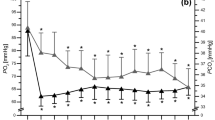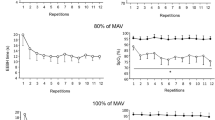Abstract
This study aimed to investigate the oxygen uptake and metabolic responses during a 400-m run reproducing the pacing strategy used in competition. A portable gas analyser was used to measure the oxygen uptake \( \left( {\dot{V}{{{\text{O}}_{ 2} }} } \right) \) of ten specifically trained runners racing on an outdoor track. The tests included (1) an incremental test to determine maximal \( \dot{V}{{{\text{O}}_{ 2} }} \,\left( {\dot{V}{{{\text{O}}_{{ 2 {\text{max}}}} }} } \right) \) and the velocity associated with \( \dot{V}{{{\text{O}}_{{ 2 {\text{max}}}} }} \left( {{\text{v}}-\dot{V}{{{\text{O}}_{{ 2 {\text{max}}}} }} } \right), \) (2) a maximal 400-m (400T) and 3) a 300-m running test (300T) reproducing the exact pacing pattern of the 400T. Blood lactate, bicarbonate concentrations \( \left[ {{\text{HCO}}_{ 3}^{ - } } \right], \) pH and arterial oxygen saturation were analysed at rest and 1, 4, 7, 10 min after the end of the 400 and 300T. The peak \( \dot{V}{{{\text{O}}_{ 2} }} \) recorded during the 400T corresponded to 93.9 ± 3.9% of \( \dot{V}{{{\text{O}}_{2\max } }} \) and was reached at 24.4 ± 3.2 s (192 ± 22 m). A significant decrease in \( \dot{V}{{{\text{O}}_{ 2} }} \) (P < 0.05) was observed in all subjects during the last 100 m, although the velocity did not decrease below \( {\text{v}}-\dot{V}_{{{\text{O}}_{{ 2 {\text{max}}}} }} . \) The \( \dot{V}{{{\text{O}}_{ 2} }} \) in the last 5 s was correlated with the pH (r = 0.86, P < 0.0005) and \( \left[ {{\text{HCO}}_{ 3}^{ - } } \right] \) (r = 0.70, P < 0.05) measured at the end of 300T. Additionally, the velocity decrease observed in the last 100 m was inversely correlated with \( \left[ {{\text{HCO}}_{ 3}^{ - } } \right] \) and pH at 300T (r = −0.83, P < 0.001, r = −0.69, P < 0.05, respectively). These track running data demonstrate that acidosis at 300 m was related to both the \( \dot{V}{{{\text{O}}_{ 2} }} \) response and the velocity decrease during the final 100 m of a 400-m run.


Similar content being viewed by others
References
Billat V, Hamard L, Koralsztein JP, Morton RH (2009) Differential modeling of anaerobic and aerobic metabolism in the 800-m and 1, 500-m run. J Appl Physiol 107:478–487
Bishop D, Bonetti D, Dawson B (2002) The influence of pacing strategy on VO2 and supramaximal kayak performance. Med Sci Sports Exerc 34:1041–1047
Bishop D, Edge J, Thomas C, Mercier J (2007) High-intensity exercise acutely decreases the membrane content of MCT1 and MCT4 and buffer capacity in human skeletal muscle. J Appl Physiol 102:616–621
Bishop D, Edge J, Mendez-Villanueva A, Thomas C, Schneiker K (2009) High-intensity exercise decreases muscle buffer capacity via a decrease in protein buffering in human skeletal muscle. Pflugers Arch 458:929–936
Dascombe BJ, Reaburn PR, Sirotic AC, Coutts AJ (2007) The reliability of the i-STAT clinical portable analyser. J Sci Med Sport 10:135–140
Dempsey J, Hanson P, Pegelow D, Claremont A, Rankin J (1982) Limitations to exercise capacity and endurance: pulmonary system. Can J Appl Sport Sci 7:4–13
Duffield R, Dawson B, Goodman C (2005) Energy system contribution to 400-metre and 800-metre track running. J Sports Sci 23:299–307
Gaesser GA, Poole DC (1996) The slow component of oxygen uptake kinetics in humans. Exerc Sport Sci Rev 24:35–71
Gallagher CG, Im Hof V, Younes M (1985) Effect of inspiratory muscle fatigue on breathing pattern. J Appl Physiol 59:1152–1158
Gardner A, Osborne M, d’Auria S, Jenkins DG (2003) A comparison of two methods for the calculation of accumulated oxygen deficit. J Sports Sci 21:151–162
Gastin PB (2001) Energy system interaction and relative contribution during maximal exercise. Sports Med 31(10):725–741
Gastin PB, Lawson DL (1994) Influence of training status on maximal accumulated oxygen deficit during all-out cycle exercise. Eur J Appl Physiol 69:321–330
Gastin PB, Costill DL, Lawson DL, Krzeminski K, McConell GK (1995) Accumulated oxygen deficit during supramaximal all-out and constant intensity exercise. Med Sci Sports Exerc 27:255–263
Granier P, Mercier B, Mercier J, Anselme F, Préfaut C (1995) Aerobic and anaerobic contribution to Wingate test performance in sprint and middle-distance runners. Eur J Appl Physiol 70:58–65
Hanon C, Gajer B (2009) Velocity and stride parameters of world-class 400-meter athletes compared with less experienced runners. J Strength Cond Res 23(2):524–531
Hanon C, Leveque JM, Vivier L, Thomas C (2007) Time course of velocity and oxygen uptake during 1500-m realized with a strategy of best chronometric performance. N Stud Athl 22:115–122
Hanon C, Leveque JM, Thomas C, Vivier L (2008) Pacing strategy and VO2 kinetics during a 1500-m race. Int J Sports Med 29:206–211
Hirvonen J, Nummela A, Rusko H, Rehunen S, Harkonen M (1992) Fatigue and changes of ATP, creatine phosphate, and lactate during the 400-m sprint. Can J Sport Sci 17:141–144
James DVB, Sandals LE, Draper SB, Wood DM (2007) Relationship between maximal oxygen uptake and oxygen uptake attained during treadmill middle-distance running. J Sports Sci 25:851–858
Jubrias SA, Crowther GJ, Shankland EG, Gronka RK, Conley KE (2003) Acidosis inhibits oxidative phosphorylation in contracting human skeletal muscle in vivo. J Physiol 553:589–599
Kindermann W, Keul J, Huber G (1977) Physical exercise after induced alkalosis (bicarbonate or tris-buffer). Eur J Appl Physiol 37:197–204
Lacour JR, Bouvat E, Barthélémy JC (1990) Post-competition blood lactate concentrations as indicators of anaerobic energy expenditure during 400-m and 800-m races. Eur J Appl Physiol 61:172–176
Miyachi M, Katayama K (1999) Effects of maximal interval training on arterial oxygen desaturation and ventilation during heavy exercise. Jpn J Physiol 49:401–407
Nielsen HB (1999) pH after competitive rowing: the lower physiological range? Acta Physiol Scand 165:113–114
Nielsen HB, Boushel R, Madsen P, Secher NH (1999) Cerebral desaturation during exercise reversed by O2 supplementation. Am J Physiol 277:H1045–H1052
Nummela A, Rusko H (1995) Time course of anaerobic and aerobic energy expenditure during short-term exhaustive running in athletes. Int J Sports Med 16:522–527
Nummela A, Vuorimaa T, Rusko H (1992) Changes in force production, blood lactate and EMG activity in the 400-m sprint. J Sports Sci 10:217–228
Perrey S, Candau R, Millet GY, Borrani F, Rouillon JD (2002) Decrease in oxygen uptake at the end of a high-intensity submaximal running in humans. Int J Sports Med 23:298–304
Poole DC, Richardson RS (1997) Determinants of oxygen uptake. Implications for exercise testing. Sports Med 24:308–320
Rasmussen J, Hanel B, Diamant B, Secher NH (1991) Muscle mass effect on arterial desaturation after maximal exercise. Med Sci Sports Exerc 23:1349–1352
Reis VM, Duarte JA, Espirto-Santo J, Russel AP (2004) Determination of accumulated oxygen deficit during a 400-m run. J Exerc Physiol Online 7:77–83
Sandals LE, Wood DM, Draper SB, James DV (2006) Influence of pacing strategy on oxygen uptake during treadmill middle-distance running. Int J Sports Med 27:37–42
Spencer MR, Gastin PB (2001) Energy system contribution during 200- to 1500-m running in highly trained athletes. Med Sci Sports Exerc 33:157–162
Thomas C, Hanon C, Perrey S, Le Chevalier JM, Couturier A, Vandewalle H (2005) Oxygen uptake response to an 800-m running race. Int J Sports Med 26:268–273
Williams CA, Doust JH, Hammond A (2006) Power output and VO2 responses during 30 s maximal isokinetic cycle sprints at different cadences in comparison to the Wingate test. IES 327–333
Yamamoto M, Kanehsia H (1995) Dynamics of anaerobic and aerobic energy supplies during sustained high intensity exercise on cycle ergometer. Eur J Appl Physiol 71:320–325
Zamparo P, Capelli C, Guerrini G (1999) Energetics of kayaking at submaximal and maximal speeds. Eur J Appl Physiol 80:542–548
Acknowledgement
The authors are grateful to the French Ministry of Health, Youth and Sport for their financial support and to B. Reine (INSEP) for his technical assistance.
Author information
Authors and Affiliations
Corresponding author
Additional information
Communicated by Susan Ward.
Rights and permissions
About this article
Cite this article
Hanon, C., Lepretre, PM., Bishop, D. et al. Oxygen uptake and blood metabolic responses to a 400-m run. Eur J Appl Physiol 109, 233–240 (2010). https://doi.org/10.1007/s00421-009-1339-4
Accepted:
Published:
Issue Date:
DOI: https://doi.org/10.1007/s00421-009-1339-4




